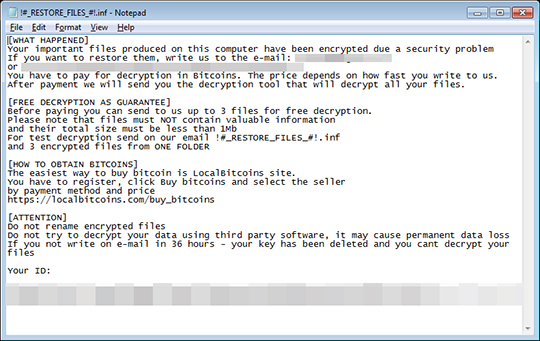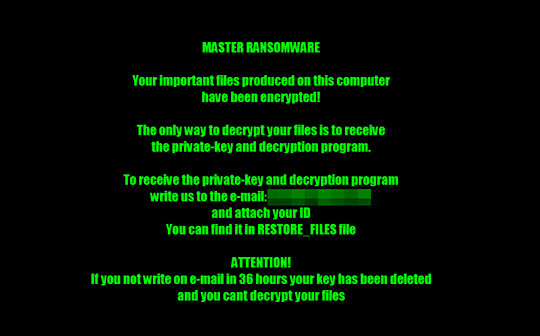RANSOM_BTCWARE.F117FE
Trojan-Ransom.Win32.Bitcovar.ah (Kaspersky), Ransom:Win32/Betisrypt!rfn (Microsoft)
Windows


Threat Type: Ransomware
Destructiveness: No
Encrypted: Yes
In the wild: Yes
OVERVIEW
This Ransomware arrives on a system as a file dropped by other malware or as a file downloaded unknowingly by users when visiting malicious sites.
It modifies the Internet Explorer Zone Settings.
It drops files as ransom note.
TECHNICAL DETAILS
Arrival Details
This Ransomware arrives on a system as a file dropped by other malware or as a file downloaded unknowingly by users when visiting malicious sites.
Installation
This Ransomware drops the following component file(s):
- %AppDataLocal%\1.bmp ← ransom wallpaper
(Note: %AppDataLocal% is the Application Data folder found in Local Settings, where it is usually C:\Documents and Settings\{user name}\Local Settings\Application Data on Windows 2000, Windows Server 2003, and Windows XP (32- and 64-bit); C:\Users\{user name}\AppData\Local on Windows Vista (32- and 64-bit), Windows 7 (32- and 64-bit), Windows 8 (32- and 64-bit), Windows 8.1 (32- and 64-bit), Windows Server 2008, and Windows Server 2012.)
Other System Modifications
This Ransomware adds the following registry entries:
HKEY_CURRENT_USER\Software\Microsoft\
Windows\CurrentVersion\Run
DECRYPTINFO = "%AppData%\Roaming\!#_RESTORE_FILES_#!.inf"
It sets the system's desktop wallpaper to the following image:
Web Browser Home Page and Search Page Modification
This Ransomware modifies the Internet Explorer Zone Settings.
Other Details
This Ransomware does the following:
- It executes the following commands:
- bcdedit.exe /set {default} bootstatuspolicy ignoreallfailures
- bcdedit.exe /set {default} recoveryenabled No
- vssadmin.exe delete shadows /all /quiet
- vssadmin.exe Delete Shadows /All /Quiet
Ransomware Routine
This Ransomware avoids encrypting files found in the following folders:
- $Recycle.Bin
- Appdata
- Intel
- Msocache
- Nvidia
- Program Files
- Program Files (x86)
- Programdata
- Windows
It renames encrypted files using the following names:
- {filename}.[teroda@bigmir.net].master
It drops the following file(s) as ransom note:
- !#_RESTORE_FILES_#!.inf

SOLUTION
Step 1
Before doing any scans, Windows XP, Windows Vista, and Windows 7 users must disable System Restore to allow full scanning of their computers.
Step 2
Delete this registry value
Important: Editing the Windows Registry incorrectly can lead to irreversible system malfunction. Please do this step only if you know how or you can ask assistance from your system administrator. Else, check this Microsoft article first before modifying your computer's registry.
- In HKEY_CURRENT_USER\Software\Microsoft\Windows\CurrentVersion\Run
- DECRYPTINFO = "%AppData%\Roaming\!#_RESTORE_FILES_#!.inf"
- DECRYPTINFO = "%AppData%\Roaming\!#_RESTORE_FILES_#!.inf"
Step 3
Scan your computer with your Trend Micro product to delete files detected as RANSOM_BTCWARE.F117FE. If the detected files have already been cleaned, deleted, or quarantined by your Trend Micro product, no further step is required. You may opt to simply delete the quarantined files. Please check this Knowledge Base page for more information.
Step 4
Reset the Internet Explorer Home and Search pages
Step 5
Restore encrypted files from backup.
Step 6
Reset your Desktop properties
Did this description help? Tell us how we did.


